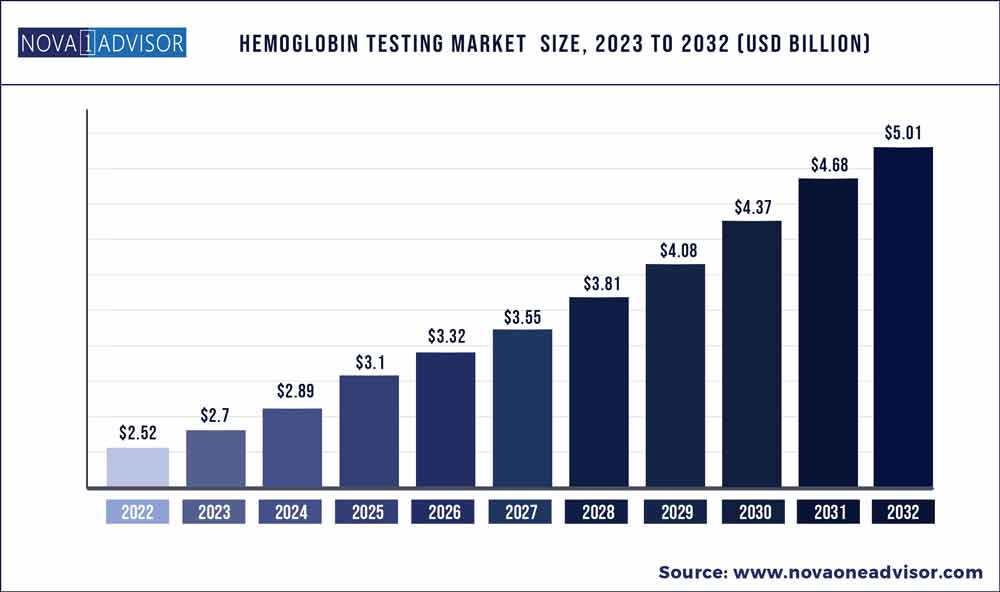The global hemoglobin testing market size was exhibited at USD 2.52 billion in 2022 and is projected to hit around USD 5.01 billion by 2032, growing at a CAGR of 7.11% during the forecast period 2023 to 2032.

Key Pointers:
- By geography, The Europe region is predicted to grow by 5.10% over from 2023 to 2032.
- By product, the point of care segment generated more than 82.9% of revenue share in 2022.
- By technology, the spectrophotometry segment captured the largest share from 2023 to 2032.
- By end use, the hospital segment is expected to grow considerably at a CAGR of 5.75%. from 2023 to 2032.
Hemoglobin Testing Market Report Scope
|
Report Coverage
|
Details
|
|
Market Size in 2023
|
USD 2.7 Billion
|
|
Market Size by 2032
|
USD 5.01 Billion
|
|
Growth Rate From 2023 to 2032
|
CAGR of 7.11%
|
|
Base Year
|
2022
|
|
Forecast Period
|
2023 to 2032
|
|
Segments Covered
|
By Product, By Technology and By End Use
|
|
Market Analysis (Terms Used)
|
Value (US$ Million/Billion) or (Volume/Units)
|
|
Regional Scope
|
North America; Europe; Asia Pacific; Central and South America; the Middle East and Africa
|
|
Key Companies Profiled
|
DiaSys Diagnostic Systems, Masimo, ARKRAY, Fisher Scientific, Bayer Medical Care, Abbott Laboratories, Beckman Coulter Diagnostics, Danaher, F. Hoffmann-La Roche, ACON Laboratories, Diazyme Laboratories, Radiometer, EKF Diagnostics Holdings, Alere, Epinex Diagnostics, Bio-Rad Laboratories, Erba Diagnostics, Daiichi Biotech, Sysmex Corporation and Others.
|
Hemoglobin is a protein found in the red blood cells (RBCs) that carries out oxygen transportation throughout the body. Hemoglobin tests are carried out to measure the amount of hemoglobin present in the blood. These tests are usually performed during complete blood count as a routine health checkup or to determine the presence of any disease, which could occur due to low count of RBCs. Patients commonly undergo hemoglobin test due to reasons such as fatigue, poor health, or unexplained weight loss. The centralized hemoglobin testing methods are useful for the diagnosis of diabetes and anemia.
In home care testing, the laboratories send a professional person to the patients doorstep for blood sample collection and there is no need to visit laboratories or hospitals for tests. After the tests are conducted, the results are electronically sent back to the patient.
As most patients prefer home care testing to laboratories, there is growth in demand for direct-to-consumer testing, which is a major factor that drives the market growth. Moreover, the emergence of advanced techniques has improved the ease of testing and provides quick test results. Hence, the development of advanced hemoglobin testing devices is further expected to boost the market growth during the forecast period. However, high cost and maintenance associated with hemoglobin testing may hinder the market growth.
The global hemoglobin testing market is segmented based on technology, end user, and geography. Based on technology, it is divided into chromatography, immunoassay, and other. Based on end user, it is categorized into hospitals, research centers, and laboratories. Based on region, it is analyzed across North America, Europe, Asia-Pacific, and LAMEA.
Some of the prominent players in the Hemoglobin Testing Market include:
- DiaSys Diagnostic Systems
- Masimo
- ARKRAY
- Fisher Scientific
- Bayer Medical Care
- Abbott Laboratories
- Beckman Coulter Diagnostics
- Danaher
- F. Hoffmann-La Roche
- ACON Laboratories
- Diazyme Laboratories
- Radiometer
- EKF Diagnostics Holdings
- Alere
- Epinex Diagnostics
- Bio-Rad Laboratories
- Erba Diagnostics
- Daiichi Biotech
- Sysmex Corporation
Segments Covered in the Report
This report forecasts revenue growth at global, regional, and country levels and provides an analysis of the latest industry trends in each of the sub-segments from 2018 to 2032. For this study, Nova one advisor, Inc. has segmented the global Hemoglobin Testing market.
By Product
- Equipment
- Point of Care
- Portable
- Handheld
- Bench-top
- Laboratory Analyzers
- Consumables
By Technology
- Chromatography
- Immunoassay
- Spectrophotometry
- Others
By End Use
- Hospitals
- Clinics
- Laboratories
- Home Care Settings
- Blood Banks
- Others
By Region
- North America
- Europe
- Asia-Pacific
- Latin America
- Middle East & Africa (MEA)

